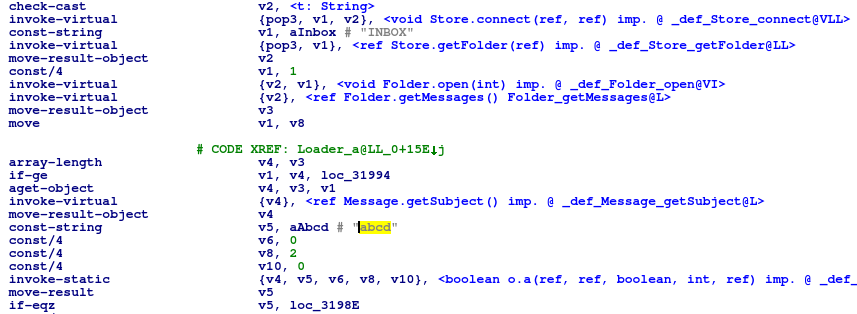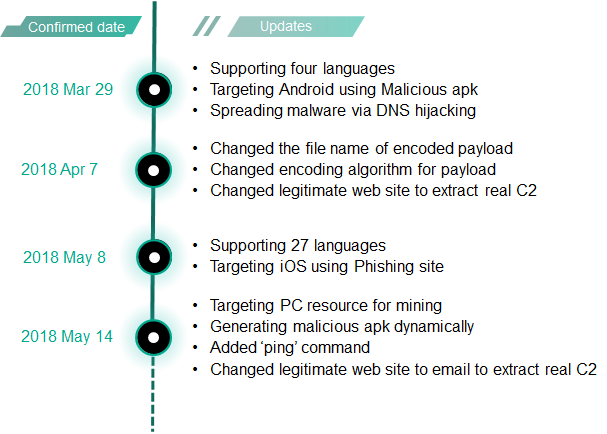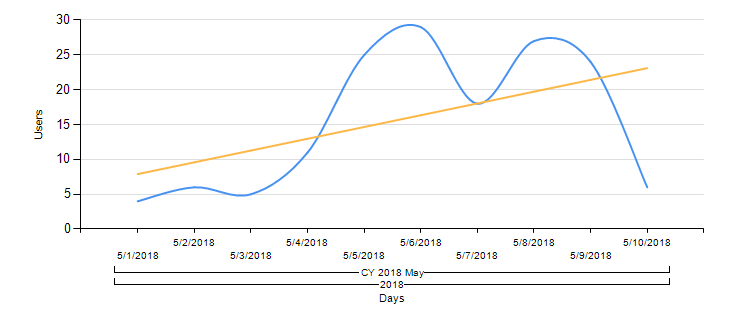
In April 2018, Kaspersky Lab published a blogpost titled ‘Roaming Mantis uses DNS hijacking to infect Android smartphones’. Roaming Mantis uses Android malware which is designed to spread via DNS hijacking and targets Android devices. This activity is located mostly in Asia (South Korea, Bangladesh and Japan) based on our telemetry data. Potential victims were redirected by DNS hijacking to a malicious web page that distributed a Trojanized application spoofed Facebook or Chrome that is then installed manually by users. The application actually contained an Android Trojan-Banker.
Soon after our publication it was brought to our attention that other researchers were also focused on this malware family. There was also another publication after we released our own blog. We’d like to acknowledge the good work of our colleagues from other security companies McAfee and TrendMicro covering this threat independently. If you are interested in this topic, you may find the following articles useful:
- Android Banking Trojan MoqHao Spreading via SMS Phishing in South Korea
- XLoader Android Spyware and Banking Trojan Distributed via DNS Spoofing
In May, while monitoring Roaming Mantis, aka MoqHao and XLoader, we observed significant changes in their M.O. The group’s activity expanded geographically and they broadened their attack/evasion methods. Their landing pages and malicious apk files now support 27 languages covering Europe and the Middle East. In addition, the criminals added a phishing option for iOS devices, and crypto-mining capabilities for the PC.
27 languages: targeting the world
In our previous blogpost we mentioned that a user attempting to connect to any websites while using a hijacked DNS, will be redirected to malicious landing pages on the rogue server. The landing page displays a popup message that corresponds to the language settings of the device and which urges the user to download a malicious apk file named ‘facebook.apk’ or ‘chrome.apk’.
Kaspersky Lab confirmed several languages hardcoded in the HTML source of the landing page to display the popup message.
The attackers substantially extended their target languages from four to 27, including European and Middle Eastern languages. And yet, they keep adding comments in Simplified Chinese.
But, of course, this multilingualism is not limited to the landing page. The most recent malicious apk (MD5:”fbe10ce5631305ca8bf8cd17ba1a0a35″) also was expanded to supports 27 languages.
The landing page and malicious apk now support the following languages:
- Arabic
- Bulgarian
- Bengali
- Czech
- German
- English
- Spanish
- Hebrew
- Hindi
- Armenian
- Indonesian
- Italian
- Japanese
- Georgian
- Korean
- Malay
- Polish
- Portuguese
- Russian
- Serbo-Croatian
- Thai
- Tagalog
- Turkish
- Ukrainian
- Vietnamese
- Traditional Chinese
- Simplified Chinese
We believe the attacker made use of an easy method to potentially infect more users, by translating their initial set of languages with an automatic translator.
Apple phishing site for iOS device
Previously, this criminal group focused on Android devices only. They have apparently changed their monetizing strategy since then. The attackers now target iOS devices as well, using a phishing site to steal user credentials. When a user connects to the landing page via iOS devices, the user is redirected to ‘http://security.apple.com/’:
A legitimate DNS server wouldn’t be able to resolve a domain name like that, because it simply doesn’t exist. However, a user connecting via a compromised router can access the landing page because the rogue DNS service resolves this domain to the IP address 172.247.116[.]155. The final page is a phishing page mimicking the Apple website with the very reassuring domain name ‘security.apple.com’ in the address bar of the browser.
The phishing site steals user ID, password, card number, card expiration date and CVV. The HTML source of the phishing site also supports 25 languages.
The supported languages are almost the same as on the landing pages and malicious apk files – only Bengali and Georgian are missing from the phishing site.
Web crypto mining for PC
Looking at the HTML source code of the landing page, we also discovered a new feature: web mining via a special script executed in the browser. More details about web miners can be found in our blogpost ‘Mining is the new black‘.
Coinhive is the most popular web miner used by cybercriminals around the world. When a user connects to the landing page from a PC, the CPU usage will drastically increase because of the crypto mining activity in the browser.
Real C2 destination is hidden in email subject
Older malicious apk samples include a legitimate website, accounts and a regular expression for retrieving the real C2 address, which the malware connects to by using a web socket. This process for obtaining its C2 changes in more recent samples, further described below:
| MD5 | f3ca571b2d1f0ecff371fb82119d1afe | 4d9a7e425f8c8b02d598ef0a0a776a58 | fbe10ce5631305ca8bf8cd17ba1a0a35 |
| Date | March 29 2018 | April 7 2018 | May 14 2018 |
| File name | chrome.apk | facebook.apk | $random_num{8}.apk |
| Legitimate web | http://my.tv.sohu[.]com/user/%s | https://www.baidu[.]com/p/%s/detail | n/a |
| n/a | n/a | @outlook.com | |
| Accounts | 329505231 329505325 329505338 |
haoxingfu88 haoxingfu12389 wokaixin158998 |
haoxingfu11 haoxingfu22 haoxingfu33 |
| RegExp | "<p>([\u4e00-\u9fa5]+?)</p>\s+</div>" | "公司</span>([\\u4e00-\\u9fa5]+?)<" | “abcd” |
| Encrypted dex | \assets\db | \assets\data.sql | \assets\data.sql |
| Encoding | Base64 | Base64 + zlib compression | Base64 + zlib compression |
Older samples retrieved the next C2 by accessing the legitimate website, extracting a Chinese string from a specific part of the HTML code, and decoding it. This scheme has been changed in the recent sample. Instead of using HTML protocol, it now uses email protocol to retrieve the C2.
The malware connects to an email inbox using hardcoded outlook.com credentials via POP3. It then obtains the email subject (in Chinese) and extracts the real C2 address using the string “abcd” as an anchor.
The old and new decoding functions are exactly the same.
We decoded the following next stage C2 servers:
- 220.136.78[.]40
- 220.136.73[.]107
Backdoor command “ping”
Kaspersky Lab observed that the previous malicious apk (MD5:f3ca571b2d1f0ecff371fb82119d1afe) had 18 backdoor commands to confirm victims’ environments and to control devices.
According to our analysis, the recent malicious apk (MD5:fbe10ce5631305ca8bf8cd17ba1a0a35) now implements 19 backdoor commands: “ping” was added.
The backdoor commands in the recent sample are as follows:
- sendSms
- setWifi
- gcont
- lock
- bc
- setForward
- getForward
- hasPkg
- setRingerMode
- setRecEnable
- reqState
- showHome
- getnpki
- http
- onRecordAction
- call
- get_apps
- show_fs_float_window
- ping NEW
This additional command calls the OS ping command with the IP address of the C2 server. By running this, the attackers validate the availability of the server, packet travel time or detect network filtering in the target network. This feature can also be used to detect semi-isolated research environments.
Auto-generating apk file and filename
Roaming Mantis uses a very simple detection evasion trick on the malicious server. It entails the landing page generating a filename for the malicious apk file using eight random numbers.
Aside from the filename, we also observed that all the downloaded malicious apk files are unique due to package generation in real time as of May 16, 2018. It seems the actor added automatic generation of apk per download to avoid denylisting by file hashes. This is a new feature. According to our monitoring, the apk samples downloaded on May 8, 2018 were all the same.
However, the malicious apk still contains a loader inside ‘classes.dex’ and an encrypted payload inside ‘\assets\data.sql’ that are identical to those in the previous variants. For security researchers, we have added MD5 hashes of the decrypted payloads without hashes of the whole apk files in the IoC of this report, as well as a few full apk hashes that were uploaded to VirusTotal.
Rapidly improving malicious apk and landing pages
Since our first report, Roaming Mantis has evolved quickly. The update history shows how rapidly the threat has been growing:
The actors behind it have been quite active in improving their tools. As seen in the graph below, which shows the unique detected user counts per day according to KSN data, the count increased on May 5. That date is very close to the update date of the new features on the landing pages.
Geographical expansion
Kaspersky Lab products detect Roaming Mantis’s malicious apk files as ‘Trojan-Banker.AndroidOS.Wroba’. Below is the data from Kaspersky Security Network (KSN) based on the verdict ‘Trojan-Banker.AndroidOS.Wroba.al’ from May 1 to May 10, 2018.
It’s clear from this that South Korea, Bangladesh and Japan are no longer the worst affected countries; instead, Russia, Ukraine and India bore the brunt. According to data gathered between February 9 and April 9, the unique user count was 150. It’s worth mentioning that the most recent data shows more than 120 users of Kaspersky Lab products were affected in just 10 days.
Also, it’s important to note that what we see in the KSN data is probably a tiny fraction of the overall picture. There are two reasons for that:
- Some users may be using other AV products or no products at all.
- Roaming Mantis, after all, uses DNS hijacking, which prevents even our customers from reporting a detection. However, some devices made it through – probably due to switching to cellular data or connecting to another Wi-Fi network.
Conclusions
The Roaming Mantis campaign evolved significantly in a short period of time. The earliest report of this attack was made public by researchers from McAfee in August 2017. At that time, the Roaming Mantis distribution method was SMS and there was one target: South Korea. When we first reported this attack in April 2018, it had already implemented DNS hijacking and expanded its targets to the wider Asian region.
In our report of April this year, we called it an active and rapidly changing threat. New evidence shows a dramatic expansion in the target geography to include countries from Europe, the Middle East and beyond by supporting 27 languages in total. The attackers have also gone beyond Android devices by adding iOS as a new target, and recently started targeting PC platforms – the landing page PC users are redirected to is now equipped with the Coinhive web miner.
The evasion techniques used by Roaming Mantis have also become more sophisticated. Several examples of recent additions described in this post include a new method of retrieving the C2 by using the email POP protocol, server side dynamic auto-generation of changing apk file/filenames, and the inclusion of an additional command to potentially assist in identifying research environments, have all been added.
The rapid growth of the campaign implies that those behind it have a strong financial motivation and are probably well-funded.
For our previous findings, please refer to the Securelist post Roaming Mantis uses DNS hijacking to infect Android smartphones.
Kaspersky products detect this malware as:
- HEUR:Trojan-Banker.AndroidOS.Wroba
Kaspersky Lab products block the Coinhive web miner for PC.
IoCs
Malicious hosts:
- 43.240.14[.]44
- 118.168.201[.]70 NEW
- 118.168.202[.]125 NEW
- 128.14.50[.]147
- 172.247.116[.]155 NEW
- 220.136.73[.]107 NEW
- 220.136.76[.]200
- 220.136.78[.]40 NEW
- 220.136.111[.]66
- 220.136.179[.]5
- 220.136.182[.]72 NEW
- shaoye11.hopto[.]org
- haoxingfu01.ddns[.]net
Malicious apks:
- 03108e7f426416b0eaca9132f082d568
- 07eab01094567c6d62a73f7098634eb8 NEW
- 1cc88a79424091121a83d58b6886ea7a
- 2a1da7e17edaefc0468dbf25a0f60390
- 31e61e52d38f19cf3958df2239fba1a7
- 34efc3ebf51a6511c0d12cce7592db73
- 4d9a7e425f8c8b02d598ef0a0a776a58
- 531714703557a58584a102ecc34162ff NEW
- 904b4d615c05952bcf58f35acadee5c1
- 9f94c34aae5c7d50bc0997d043df032b NEW
- a21322b2416fce17a1877542d16929d5
- b84b0d5f128a8e0621733a6f3b412e19
- bd90279ad5c5a813bc34c06093665e55
- cc1e4d3af5698feb36878df0233ab14a NEW
- ff163a92f2622f2b8330a5730d3d636c
- 808b186ddfa5e62ee882d5bdb94cc6e2
- ee0718c18b2e9f941b5d0327a27fbda1 NEW
classes.dex:
- 13c8dda30b866e84163f82b95008790a NEW
- 19e3daf40460aea22962d98de4bc32d2
- 1b984d8cb76297efa911a3c49805432e NEW
- 36b2609a98aa39c730c2f5b49097d0ad
- 3ba4882dbf2dd6bd4fc0f54ec1373f4c
- 46c34be9b3ff01e73153937ef35b0766 NEW
- 5145c98d809bc014c3af39415be8c9ac NEW
- 6116dc0a59e4859a32caddaefda4dbf4 NEW
- 8a4ed9c4a66d7ccb3d155f85383ea3b3
- a5d2403b98cddcd80b79a4658df4d147 NEW
- b43335b043212355619fd827b01be9a0
- b4152bee9eca9eb247353e0ecab37aa5 NEW
- b7afa4b2dafb57886fc47a1355824199
- bf5538df0688961ef6fccb5854883a20 NEW
- f89214bfa4b4ac9000087e4253e7f754
- 6cac4c9eda750a69e435c801a7ca7b8d
- e56cccd689a9e354cb539bb069733a43 NEW
- fe0198f4b3d9dc501c2b7db2750a228b NEW
Decrypted payload (dex file) from \assets\data.sql:
- 1bd7815bece1b54b7728b8dd16f1d3a9
- 28ef823d10a3b78f8840310484e3cc69 NEW
- 307d2780185ba2b8c5ad4c9256407504
- 3e01b64fb9fe9605fee7c07e42907a3b NEW
- 3e4bff0e8ed962f3c420692a35d2e503
- 3ed3b8ecce178c2e977a269524f43576 NEW
- 57abbe642b85fa00b1f76f62acad4d3b
- 6e1926d548ffac0f6cedfb4a4f49196e
- 6d5f6065ec4112f1581732206539e72e NEW
- 7714321baf6a54b09baa6a777b9742ef
- 7aa46b4d67c3ab07caa53e8d8df3005c
- a0f88c77b183da227b9902968862c2b9
- b964645e76689d7e0d09234fb7854ede


































Roaming Mantis dabbles in mining and phishing multilingually